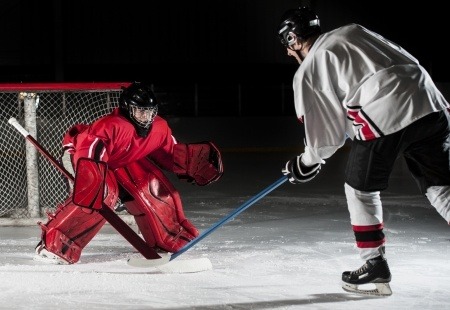
Winter is here and it’s hockey season! Hockey is a fast paced and exciting game that is unlike any other major sport because it requires a completely different mode of transportation. Hockey is the only major sport that isn’t played on your feet; athletes are on skates. Thus, it requires a unique style of training and there are some important factors to address when programming for hockey athletes.

I fell in love with fitness and training while I was in high school. I was the captain of my high school ice hockey team; we didn’t have an athletic trainer provided by the school, so I took it upon myself to put together an off ice training program for the team. I studied books on hockey training, I watched videos of training drills, and put together a program for the team. It was fun, rewarding, and challenging. Since hockey is played on skates it is important to understand the mechanics of ice-skating while determining which exercises will best prepare the players for competition. Ice-skating requires you to generate lateral power to propel yourself forward unlike the power needed to run in other sports.
It is important to consider the muscles and skills that are used most during a sport to determine the most effective way to train. Listed below are the muscles that are used frequently in hockey as well as a couple of exercises to target them:
Glutes – When skating each stride requires an extension of the hips to propel forward. The glutes are the primary hip extensor and are very important for generating powerful forces to produce a fast skater.
Exercises for Glutes– Squats, Deadlifts, Hip Bridges, Lateral Lunges
Abductors – Abductors are also used in every stride to push laterally while skating. These are second to glutes in generating the lateral power needed to skate.
Exercises for Abductors– Laying Side Leg Raises, Standing Side Leg Raises w/Resistance, Fire Hydrants, Clams.
Quads– Quads take the brunt of the work while skating with the knees bent, which is almost the entire game. Quad strength is necessary , but muscular endurance is vital considering the skater is practically doing a wall sit the entire time on the ice.
Quad Exercises– Squats, Lunges, Wall Sits, Light Weight High Rep Quad Extensions
Core –Core muscles are used every time to change directions, check someone, and while taking shots. It is important not only to have a stable core, but also be able to generate rotational power for shots.
Core Exercises- Pallof Press Variations, Plank, Side Plank, Banded Twists, Russian Twists, Wood Chops
Playing hockey and skating frequently works certain muscles more than others. If unaddressed, these muscular imbalances can lead to injuries, which means your athletes are putting ice on their bodies instead of playing on the ice. Nobody wants that, so pay close attention to the following potential muscular imbalances and work the opposing muscles extra hard to maintain balance.
Adductors– When pushing off laterally you are using your abductors muscles. If you’re constantly using your abductors the adductors will be weak in comparison and can lead to IT band and glute injuries.
Adductor Exercises-Banded Hip Adductions, Laying Lower Leg Lift, Adduction Machine
Hamstrings – Skating is very quad dominant and does not incorporate the hamstrings nearly as much. Weak hamstrings can lead to a higher prevalence of hamstring and knee injuries.
Hamstring Exercises – Straight Leg Deadlifts, Single Leg Deadlifts, Swiss Ball Hamstring Curls, Laying Hamstring Curls
How to Train for Hockey
Another consideration when programming for ice hockey training is the length of time on the ice per shift. Shifts can last anywhere from 30 seconds to 2 minutes or more depending on the situation. This is an important factor when developing the cardiovascular program for your athlete. Usually teams run 3-4 lines of players on offense and 3 lines on defense meaning that time on the ice or work time vs. rest time is around 3-1. The time spent on the ice often includes short bursts of maximum effort followed by gliding on the skates.
Therefore, the most effective style of conditioning for hockey would be some style of High Intensity Interval Training. I had my players training using this method before I ever heard the term HIIT. This style of training fits with the flow of the game and helps condition the body for what will be experienced on the ice. This helps your athletes recover quicker between shifts then if you trained them doing typical “cardio” like jogging at a steady pace on the treadmill. You’ll have to determine based on the age, ability, and fitness levels of your players what the appropriate rest to work ratios will be, but HIIT is perfect for ice hockey conditioning.
Hockey is completely different than other sports and requires a unique program to produce the best possible results. There are plenty of additional exercises and drills that would be beneficial to ice hockey players; the ones I provided are just some of my favorites. Have fun with the programming and make it your own.
If you have questions about the program, visit the NFPT Facebook page and ask Mike! Or, share some of your favorite exercises for hockey.



